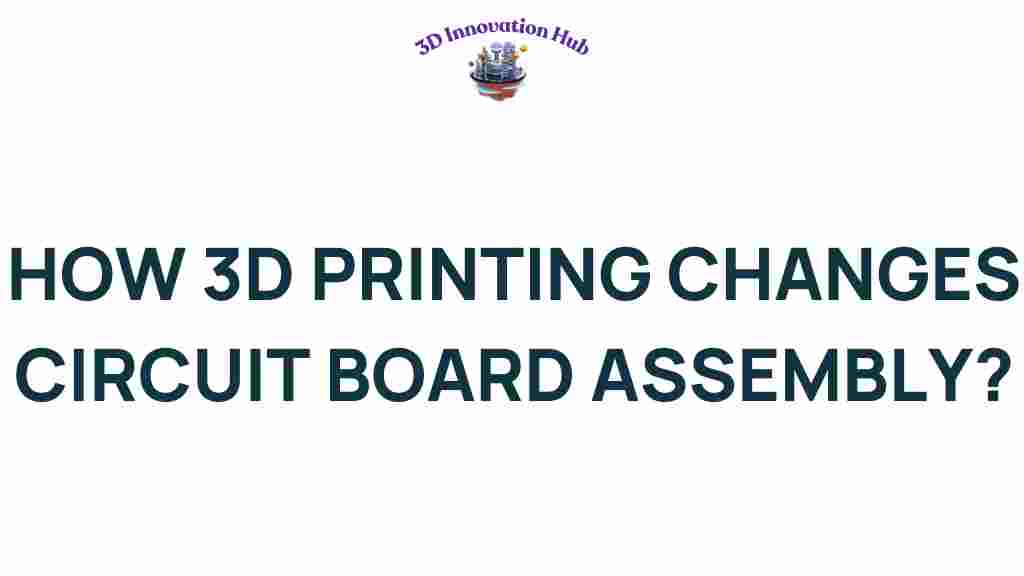How 3D Printing Revolutionizes Circuit Board Assembly
In recent years, 3D printing has emerged as a groundbreaking technology, not just in the realm of manufacturing but specifically in the assembly of circuit boards. This innovative approach to electronics manufacturing is reshaping the industry by enhancing efficiency, reducing costs, and accelerating the prototyping process. In this article, we’ll explore how 3D printing is revolutionizing circuit board assembly, delving into its benefits, the technology involved, and step-by-step processes that can be employed in this transformative practice.
The Importance of 3D Printing in Circuit Board Assembly
The intersection of 3D printing and circuit board assembly represents a significant leap forward in manufacturing technology. Traditionally, circuit board assembly has required a series of complex, time-consuming steps that involve multiple materials and processes. With the advent of 3D printing, manufacturers can streamline these processes, leading to:
- Enhanced Prototyping: 3D printing allows for rapid prototyping of circuit boards, enabling engineers to iterate designs quickly.
- Cost Efficiency: Reducing the need for multiple components can significantly lower production costs.
- Customization: 3D printing enables the creation of tailored circuit boards that meet specific needs without the excess of traditional manufacturing methods.
- Reduced Waste: This technology minimizes material waste, fostering a more sustainable manufacturing process.
How 3D Printing is Transforming the Manufacturing Process
The integration of 3D printing into the circuit board assembly process involves several key innovations and technologies:
1. Material Versatility
Modern 3D printers can utilize a variety of materials, including:
- Conductive Inks: These inks allow for the printing of electrical pathways directly onto the board.
- Flexible Filaments: Useful for creating bendable circuit boards.
- Abs and PLA: Common thermoplastics that can serve as base materials.
2. Layered Manufacturing
3D printing employs a layered manufacturing process which allows for complex and intricate designs that were previously difficult or impossible to achieve with traditional methods. Each layer can be a different material, allowing for:
- Multi-functional Components: Integrating various functions into a single component.
- Compact Designs: Reducing the footprint of circuit assemblies.
3. Automation and Speed
The automation capabilities of 3D printing streamline the assembly process, allowing for rapid production cycles. This speed is critical in industries where time-to-market is essential, such as:
- Consumer electronics
- Medical devices
- Automotive components
Step-by-Step Process of 3D Printing Circuit Boards
To effectively utilize 3D printing in circuit board assembly, manufacturers can follow a structured process:
Step 1: Design the Circuit Board
The first step involves creating a design using CAD (Computer-Aided Design) software. It’s essential to ensure that the design includes:
- Electrical pathways
- Component placements
- Connections for power and data transfer
Step 2: Select the Appropriate Materials
Choosing the right materials is crucial for ensuring that the circuit board functions correctly. Depending on the design, options may include:
- Conductive materials for pathways
- Insulative materials for base layers
Step 3: 3D Print the Circuit Board
Using a compatible 3D printer, the circuit board can be printed layer by layer. This involves:
- Loading the materials into the printer
- Setting up the print parameters
- Starting the print job and monitoring for any issues
Step 4: Post-Processing
After printing, the circuit board may require post-processing, which can include:
- Removing support structures
- Cleaning the surface
- Applying coatings or finishes for protection
Step 5: Assembly of Components
Once the base is ready, electronic components can be soldered or affixed to the board, completing the assembly process. This step may involve:
- Using automated soldering tools
- Manual placement for sensitive components
Step 6: Testing the Circuit Board
Finally, testing the assembled circuit board is essential to ensure functionality. This can include:
- Electrical testing
- Functional testing under various conditions
Troubleshooting Common Issues in 3D Printed Circuit Board Assembly
While 3D printing offers many benefits, challenges can arise during the circuit board assembly process. Here are some common issues and their solutions:
1. Poor Layer Adhesion
Issue: Inadequate bonding between layers can lead to structural weaknesses.
Solution: Ensure the appropriate temperature settings and material compatibility. Increasing the printing temperature or adjusting the cooling rate can help improve adhesion.
2. Conductive Pathway Failures
Issue: Faulty conductive pathways can result in circuit failure.
Solution: Utilize higher-quality conductive inks and ensure that the printing process is correctly calibrated to avoid interruptions in the pathways.
3. Component Misalignment
Issue: Components may not align correctly during assembly.
Solution: Use precise placement tools and verify that the CAD design includes adequate tolerance for component size and placement.
Conclusion
In conclusion, 3D printing is revolutionizing circuit board assembly through its innovative approaches to efficiency and prototyping. The technology not only shortens the manufacturing cycle but also opens doors for customization and sustainability. As the technology continues to evolve, we can expect even more advancements in the field of electronics manufacturing. Embracing these innovations will be crucial for businesses looking to stay competitive in the fast-paced world of technology.
For further reading on advancements in 3D printing technology, check out this resource. If you’re interested in practical applications and case studies on circuit board assembly, visit this page.
This article is in the category and created by 3D Innovation Hub Team
